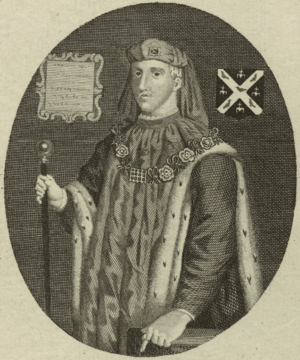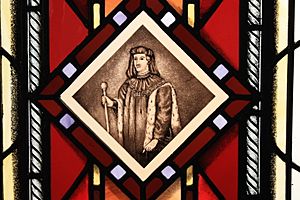Henry fitz Ailwin facts for kids
Quick facts for kids
Henry fitz Ailwin de Londonstane
|
|
|---|---|

Engraving of Henry fitz Ailwin
|
|
| 1st Lord Mayor of London | |
| In office 1189–1212 |
|
| Preceded by | Office established |
| Succeeded by | Roger FitzAlan |
| Personal details | |
| Born | c. 1135 |
| Died | 19 September 1212 |
| Relations | Son of Ailwin fitz Leofstan, brother of Alan fitz Ailwin. |
| Children | Peter fitz Henry Alan fitz Henry Thomas fitz Henry Richard fitz Henry |
| Occupation | Businessman and landowner |
Henry fitz Ailwin de Londonstane (born around 1135 – died 19 September 1212) was an important English businessman and landowner. He became London's very first mayor in 1189. He held this important job for a long time, until he died in 1212. He was the only mayor ever to serve for his whole life!
Contents
Henry Fitz Ailwin's Family History
Henry's family was mostly English, not Norman. They had been important in London's business and city life for many years. His grandfather, Leofstan, was likely a "portreeve" of London. A portreeve was an important royal officer who helped manage London before mayors existed. In 1108, Leofstan helped start the Holy Trinity Priory, Aldgate.
Henry's father, Ailwin, owned a house where the "husting court" of London met. This court was a meeting of important city leaders. They made big decisions about the growing city of London. It was similar to earlier English "Folkmoot" meetings, where people gathered to discuss important matters. Henry's uncle, Robert, was an official in the weavers' guild in 1130. A guild was like a club for people who did the same job.
Henry Fitz Ailwin was also related to Derman and Alward. These were noblemen who served King William I. In 1086, they owned land at Watton-at-Stone. King William gave them this land for their service. This land had belonged to Ailwin Horne, who served King Edward the Confessor.
Becoming London's First Mayor
Henry fitz Ailwin was likely involved in making and selling cloth. He became an alderman by 1168. An alderman was a senior member of a city council. This made him one of the most powerful men in London.
During the reigns of King Richard I and King John, the kings needed money from London's businessmen. Because of this, London was given more freedom to govern itself. Before, a "portreeve" (a royal officer) governed the city. But then, the office of mayor was created. Henry Fitz Ailwin was first called "mayor" in 1194.
In 1193, before he became mayor, Henry was trusted with money collected for King Richard's ransom. This shows he was a wealthy and respected man. He was also very skilled at dealing with different groups and both kings.
Important Work as Mayor
In 1208, Henry helped arrange for land outside the city walls to be used as a burial ground. After a terrible fire in London in 1212, he and other city officials created new rules for building. These rules focused on preventing fires and making buildings safer.
Henry Fitz Ailwin also created a law called the Assize of Building. This law helped shape modern property rules. It allowed ten men, who became known as aldermen, to make decisions about building. Since a big fire had destroyed much of London earlier, Henry wanted new rules for building houses with stone.
He also gave a lot of money to churches and hospitals. He supported:
- Holy Trinity Priory
- St Bartholomew's Hospital
- Westminster Abbey
- The Chapel of St Thomas on the Bridge (finished in 1209)
- The nunneries of St Mary, Clerkenwell and Godstow
He also helped start St. Mary Spital. At Watton-at-Stone, he was remembered for founding a chapel. Henry died on September 19, 1212. He was buried in Holy Trinity Priory, Aldgate. His tomb could still be seen there centuries later. There was also a memorial for him in the church of St Mary Bothaw.
Henry's Properties
Henry fitz Ailwin's main home and business office was a large house near St Swithin's Church. This house was close to the London Stone, a mysterious and ancient stone linked to London's history. His house could be reached from St Swithin's Lane or Candlewick Street (now Cannon Street). This house later became the site of Salter's Hall.
In old documents, Henry was sometimes called "of Londonstone." This showed his connection to this important landmark.
In 1165, Henry and his brother Alan inherited their father's lands. This included land at Watton-at-Stone in Hertfordshire, which became his country home. He also owned many properties in the eastern part of London. He had land in Edmonton in Middlesex, in Surrey, and by the Thames river in Kent.
Henry's Family Life
Henry's wife was named Margaret. She was probably the mother of his four sons: Peter, Alan, Thomas, and Richard. Peter was the oldest. He married Isabel, and they had children, including a daughter named Margaret. Peter died sometime between 1203 and 1211, before his father. Henry Fitz Ailwin died in 1212. His wife Margaret and three of his sons were still alive when he passed away.
Henry's son Alan got married and had at least one child, Robert FitzAlan. Alan is buried at Robertsbridge Abbey. Henry Fitz Ailwin's main heir was his granddaughter Joan. She was the daughter of his eldest son, Peter. Joan FitzPeter married William IV Aguillon. In 1235, she was the mother of Sir Robert II Aguillon.
A former president of Chile, Patricio Aylwin Azócar, is a distant relative of Henry fitz Ailwin.
Images for kids



